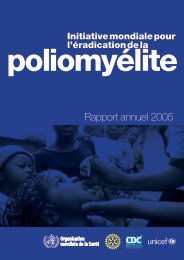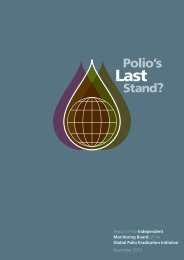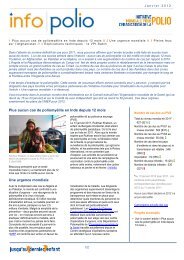(EAP) 2012-2013 - Global Polio Eradication Initiative
(EAP) 2012-2013 - Global Polio Eradication Initiative
(EAP) 2012-2013 - Global Polio Eradication Initiative
You also want an ePaper? Increase the reach of your titles
YUMPU automatically turns print PDFs into web optimized ePapers that Google loves.
24 global <strong>Polio</strong> emergency action Plan <strong>2012</strong>-13<br />
national oversight and accountability<br />
A National Coordination Committee has been established<br />
to oversee implementation of the Emergency<br />
Plan, which is convened by the Minister of Health and<br />
includes the heads of key partner agencies. An external<br />
evaluation of the implementation of the Plan will be<br />
held in <strong>2012</strong>.<br />
siA and vaccine plans<br />
DRC is planning to conduct two national and six subnational<br />
rounds in <strong>2012</strong> and two national and two subnational<br />
rounds in <strong>2013</strong>. Trivalent OPV will be used in<br />
at least one national and one subnational round each<br />
year; in areas of recent cVDPV circulation, tOPV will<br />
be used in multiple rounds. Remaining rounds will be<br />
conducted with bOPV to ensure high levels of immunity<br />
against the two WPV serotypes.<br />
Angola<br />
situational Analysis<br />
Action to stop polio now in nigeriA, pAkistAn And AfghAnistAn<br />
key activities to sustain momentum<br />
The Emergency Plan outlines a series of key steps to<br />
improve the implementation of polio eradication activities,<br />
particularly in eastern DR Congo. These include<br />
sustained government and human resource surge for<br />
technical support in high risk areas; special investigations<br />
on reasons why children are being missed,<br />
including anthropological surveys and direct contact<br />
with religious and community leaders to inform them<br />
about the benefits of immunization. A heavy emphasis<br />
is placed on communication strategies to build demand<br />
for immunization; the targeting of wider age groups<br />
in key high-risk areas; the intensive review of micro<br />
plans; special attention to the selection, training, and<br />
supervision of immunization teams; and improved AFP<br />
surveillance.<br />
polio cases, 2011 5.cases.(WPV1) 85% decrease in<br />
worst performing areas,2011 Luanda<br />
wpV cases compared<br />
to 2010<br />
Angola has reported only five cases due to<br />
wild poliovirus in 2011, a significant decrease<br />
from the 33 reported in 2010. In the first<br />
quarter, transmission of the re-established<br />
WPV1 in the south-east of the country<br />
accounted for four cases; however, that<br />
particular lineage has not been detected since<br />
March 2011. In July a single case was reported<br />
from Uige province in the north, bordering the<br />
then active transmission zone of Bandundu<br />
and Bas Congo in DR Congo, and representing<br />
a re-introduction of WPV1 from that zone.








![English [pdf 2MB] - Global Polio Eradication Initiative](https://img.yumpu.com/6380394/1/190x245/english-pdf-2mb-global-polio-eradication-initiative.jpg?quality=85)
